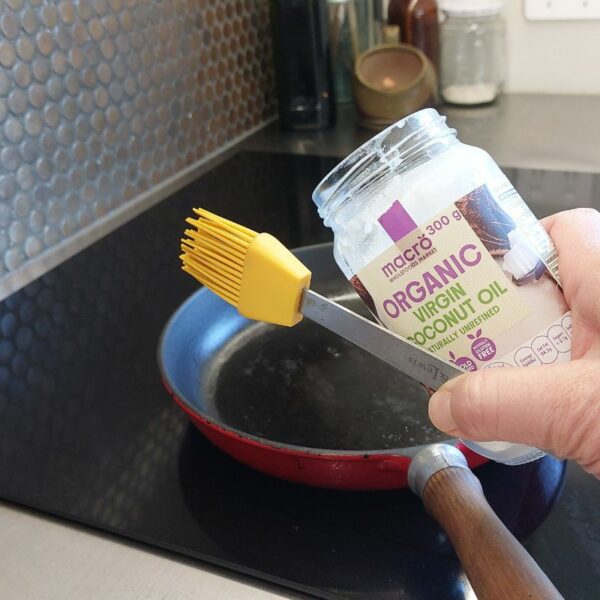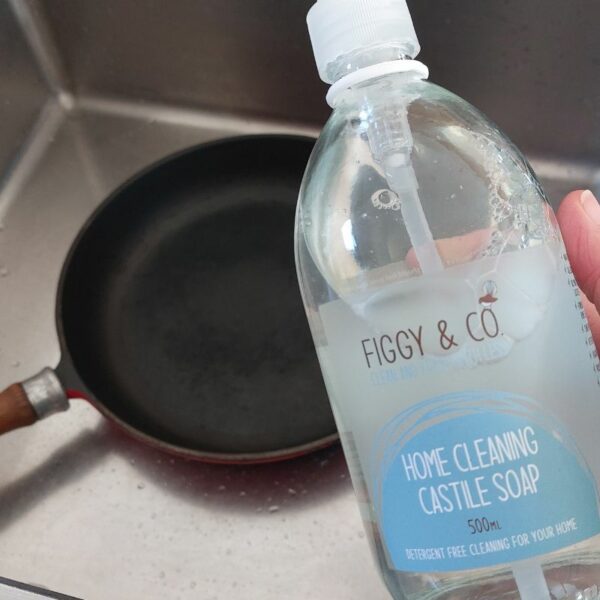Shipping $10 + $5.50 Rural | 1500+ 5 Star Reviews
Shipping $10 + $5.50 Rural | 1500+ 5 Star Reviews
Cast Iron Pan Care: 3 Cleaning steps, Seasoning, and Maintenance Tips
July 07, 2025 7 min read

A complete guide to cleaning your cast iron pan naturally!
The first thing I want you to know is this, cast iron pans don’t need to be complicated! They have so much to offer for a non-tox home. Cleaning and maintaining cast iron pans is about a couple of steps you do each time you clean them. That’s it. Cast iron pans have a bit of a bad reputation for being hard to clean – but what I have found is that if you stick this routine, then you will have no problems whatsoever. The thing is, cast iron won’t like you cutting corners – namely leaving it wet for too long. These big heavy pans, that you might have got from your granny, have Iron in them – as in the metal that rusts easily when it gets and stays wet. This (!) is what causes setbacks in what should be, a long and happy cooking partnership. This guide is all about cleaning and maintaining your cast iron pans, easily and efficiently, so you can have great results and happy non-tox cooking for years and years to come. It also covers off what is 'seasoning your pan' and, how to do it. And lastly... don't believe anyone who says you can't clean your pan with soapy water! It's just not true. Let's get cleaning our pans right!
The Easy Three Step Guide to Cleaning Your Cast Iron Pan
1. Scrub away any leftover food residue:
If the pan is still warm the food will lift easily, simply use a brush and gentle scrubber under a hot running tap. If the pan or Dutch oven has been sitting for a while and the food has got a bit stuck on – give it a short soak in hot water with a small amount of castile soap. 10 minutes or so soaking will be long enough to soften the food for it to brush off easily under the tap.
2. Wash your pan with soapy water:
When your pan is empty of water, add a small amount of castile soap (1 tsp or less will do it) and give it a quick scrub up to remove any lingering food residue from your meal. This step is a balance, hence why I have described it as a quick scrub – you want to walk the line between washing way the food from what you just cooked while not washing so aggressively that you wash off the seasoning (seasoning can be replenished but it takes time so, best to keep it in place, if you can while you clean your pan) Rinse well with warm water
3. Dry your cast iron thoroughly straight away:
Give your pan a dry with a tea towel or wrung out cloth, then pop it back onto the stove top or into the oven and heat it on a medium heat until all the water has evaporated. Drying with a towel alone is not enough. Small amounts of water can remain and cause rusting. Drying off your pan or Dutch oven thoroughly is the step that will save you 80% of cast iron cleaning drama. Don’t skip this step!
How Often Should You Clean Your Cast Iron Pan?
How often should I clean my cast iron pan? You’ll want to clean it after each use. As you build up the seasoning on your pan, it will become non-stick, and the clean ups become quicker and quicker.
Maintaining Your Cast Iron Skillet for Longevity
Oiling and maintaining your pan
- Once your pan has been thoroughly dried and cooled a little. Rub it down with a very small amount of high smoke point oil or a specific cast iron maintenance balm.
- Using high smoke point oil – use a few drops of olive oil, sesame oil, avocado oil or small smear of coconut oil. Use a cloth or silicon pastry brush to coat all the inside.

- Using a cast iron pan balm – take a small amount of balm on a dry cloth and wipe it all over the pan to get a complete covering. Use a balm like this or make one at home from 85g high smoke point oil and 15g beeswax.
-

When the pan has an even covering of oil or balm, use a dry cloth to buff away the excess oil or balm. Your pan should go from looking shiny to dull. - You can heat the pan again at this point if you want to - this helps mobilise the oil across and into all the surface of your pan which can be uneven.
How do I store my cast iron pan between uses?
Store them as you would any other kitchen equipment, either on a shelf, in a drawer or even left on the stove top! If you are stacking pans on top of each other to save room, have a protective mat between them – this could be an old tea towel folded in half.
Handling rust on your cast iron cookware
If you do get a small amount of rust on your pan because you have soaked it too long or not dried it straight away – don’t worry. The great thing about cast iron is that it’s pretty forgiving – not like Teflon if you scratch it! First, wash away the rust with soapy water, rinse well and then dry thoroughly on the stove top. Then, give it a good coating with oil or balm and buff. All fixed! If you get a second hand pan or if your cast iron gets quite rusty – give it a restoration wash with soap and a good scrub – you aren’t walking a line here, you are giving it a really good wash to get rid off all the rust and any build up. If the rust is very bad then do a first step of boiling with water and vinegar for 10 minutes before washing. The acid of the vinegar will dissolve the rust away, about 1/4 cup will be enough. Then follow the steps for seasoning.
How to Season Your Cast Iron Pan: A Detailed Process
Seasoning is the name given to using a thin coat of oil or balm on your pan and heating the pan your oven for a longer period of time in order to bond the oil to your pan to create a durable, non-stick surface for happy cooking days!
When should I season my pans?
New pans do not come with seasoning and seasoning can wear off. With normal use, you will want to season your pans roughly once a year or when you think it needs a new coating. You will need to season a brand-new pan or if you get a pan second hand and give it a restoration wash (heavy soap up with a scrubby). You will also want to season if you have had to treat for rust.
Here’s the seasoning process broken down
- Clean and dry your pan
- Coat with a thin layer of appropriate oil or cast-iron pan balm, then wipe over with a clean cloth to remove any excess
- Put your pan into a hot oven of 230 degrees for 1 hour. Repeat the oil layer again if needed.
- Turn your oven off and let it cool down
- Your pan is now 'seasoned'. You can now use your pan for cooking.
- To cook with your newly seasoned pan, heat your pan to your desired temperature, add a little butter or oil then cook as normal.
What is building up the seasoning?
You can repeat the seasoning steps of a light oil or balm, a buff and then into the oven to bake and cool. If you do season 2 or three times (though 1 is plenty enough mostly) you will have a thicker bonded surface that is more durable than if you had done one coat. This might be a good idea if you live with others that may not look after your pan with the same love and care that you do – a bit like a seat belt for your pan if the driver is a bit crazy. The key point here is to buff off the oil or balm before heating so you don't get a sticky non-bonded residue.
Common Mistakes to Avoid with Cast Iron Cookware
These pans will last hundreds of years if they are looked after right – crazy huh! They are so hard wearing, they really are perfect for everyday use. If you are lucky enough to have a family heirloom. I just adore that maybe you're using a pan that your grandparents used to cook with – it’s a real tangible connection to them!
- Don't put your pan into the dishwasher
- Be attentive to the 3 simple steeps of cleaning/drying/oiling
- Avoid anything that would cause scratching – i.e. heavy metal tooling
- Best not to take a very hot pan and submerge it into cold water – this will cause heat shock and may damage the metal.
- Seasoning with too much oil
How to Choose Cast Iron Cookware
Choosing the right cast iron cookware can make a big difference in your cooking experience. Here are some tips to help you pick the perfect pan:
- Size and Weight: Cast iron pans come in various sizes and weights – but they are all heavy compared to aluminium pans. A 24cm skillet is a versatile size that works for most dishes. Ensure the weight is manageable for you, as cast iron can be quite heavy even before adding food!
- Pre-Seasoned vs. Unseasoned: Pre-seasoned pans are ready to use right out of the box, while unseasoned ones require seasoning before use. Pre-seasoned pans save time and effort, but you may prefer to do your own seasoning with your preferred oil.
- Handles: Look for pans with handles that can go in the oven when it is time to season. If you choose a pan with a wooden handle, make sure you can easily take it off as needed. Some pans come with dual handles, making them easier to manoeuvre. You can also get handle covers to help with accidental burning as all-in-one metal handles get hot on the stove top while cooking.
- Enamelled vs. Unfinished: Enamelled cast iron is easier to clean and doesn't require seasoning, but it can be more expensive. Unfinished cast iron needs regular seasoning but offers a more traditional cooking experience.
- Brand Reputation: Brands like Lodge and New Zealand brand Ironclad are well-known for their high-quality cast iron cookware. In fact, Ironclad guarantee their pans for 100 years!
By following these steps and tips, you'll find that caring for cast iron cookware is not only manageable but also rewarding. Your pans will remain non-stick, rust-free, and a joy to cook with, all while using natural, eco-friendly methods. Happy cooking!
Get natural cleaning tips from our blog!
We want you to have everything you need to clean your home healthier while avoiding unwanted chemicals – and looking out for the planet too! Take a browse through our blog and learn more about natural cleaning, safe ingredients and so much more!

